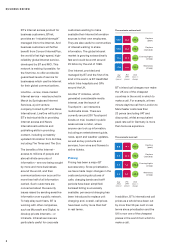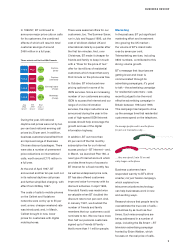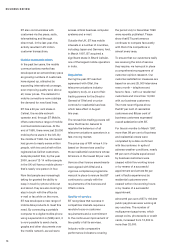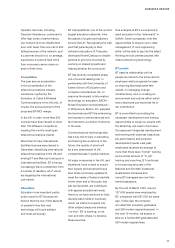BT 1997 Annual Report Download - page 18
Download and view the complete annual report
Please find page 18 of the 1997 BT annual report below. You can navigate through the pages in the report by either clicking on the pages listed below, or by using the keyword search tool below to find specific information within the annual report.
FINANCIAL REVIEW
18
Expenditure on tangible fixed assets £m Total 2,719
Transmission equipment 1,131
4
Other network equipment 503
4
Telephone exchanges 445
4
Computers and office equipment 350
4
Other 290
4
% customer lines served
by digital exchanges
64.0
74.9
82.7
87.7
92.6
93 94 95 96 97
Treasury policy
The group has a centralised treasury operation. Its
primary role is to manage liquidity, funding, investment
and the group’s financial risk, including risk from
volatility in currency and interest rates and counterparty
credit risk. The treasury operation is not a profit centre
and the objective is to manage risk at optimum cost.
The Board sets the department’s policy, and its activities
are subject to a set of controls commensurate with the
magnitude of the investments and borrowings under its
management. Counterparty credit risk is closely
monitored and managed within controls set by the Board.
Derivative instruments, including forward foreign
exchange contracts, are entered into for hedging
purposes only.
Capital resources
At 31 March 1997, the group had cash and short-term
investments of £3,000 million. At that date, £221 million
of short-term debt was outstanding.
The gearing or ratio of debt (borrowings net of cash and
short-term investments) to shareholders’ equity and
minority interests was 1.6% at 31 March 1997, compared
with 7.4% at 31 March 1996. The group had £176 million
net debt at 31 March 1997, a decrease of £849 million in
the year through cash flow. Gearing is planned to increase
substantially during the course of 1997 as a result of the
special dividend and the merger with MCI, but the Board
believes that it will begin to fall after 1998. BT issued a
$1.5 billion five-year 6 3
/4% Eurobond in April 1997 and
has subsequently announced the issue of a $1.0 billion
ten-year 7% Eurobond in preparation for the group’s cash
requirements later in 1997.
The directors have a reasonable expectation that the
group has adequate resources to continue in operational
existence for the forseeable future and therefore they
continue to adopt the going concern basis in preparing
the financial statements.
Capital expenditure
Capital expenditure on plant, equipment and property
totalled £2,719 million in the year, and was similar to the
level of the previous year. Investment has been
concentrated on improving the quality of the local access
network and extending the reach of advanced services
by making further progress in converting the UK’s few
remaining electronic telephone exchanges to full digital
operation. Additionally, Cellnet has continued the
construction of the digital cellular GSM network.
The group expects capital expenditure by the business, as
currently constituted, in the year ending 31 March 1998
to be at a level commensurate with that of the year under
review. BT expects that future capital expenditure will be
provided from net cash inflows from operating activities
supplemented, if appropriate, by external financing.
























